Friday, 11 December 2009
Another weekend in Cairo. I came down from Alexandria yesterday afternoon so I would be able to join fellow Fulbrighters on a day trip to see the pyramids. The OLD pyramids. The monsters in Giza are the most famous ones but there are many more. Today we were to visit three sites important to the history of pyramid building ancient Egypt: Saqqara, Memphis, and Dahshoura. Dr. Chahinda Karim is to be our guide again.
Dominique Ellis and Ginger da Costa have offered to host me for the weekend but before I go to their place, I have arranged to meet Mike McMullen in Sakanat Maadi for dinner. He had also offered the hospitality of his home, but after considering the matter for a while, it made more sense for me to stay closer to downtown. There were several things I wanted to do this weekend and they all involved places near the center of town, so I opted to stay in Zamalek. Mike and I met at the Metro station in Sakanat Maadi and walked a couple of blocks along Street 9, the main drag in that part of town, to Lucille’s, an up-scale burger joint that served a variety of American-style foods. At 6:30 in the evening, the place was humming, filled with groups of Egyptian teens from wealthy local families and a few ex-pats. We found a table and ordered chicken enchiladas.
While our food was being prepared, Mike and I talked about my work and his teaching sociology at AUC. The end of the semester is looming for students here, too, and students being students, there is the familiar litany of excuses and pleadings for more time and claims of extenuating circumstances that warrant grants of special consideration. We also talked about plans for the intersession; Mike is returning to the States to bring his wife and two young daughters to Egypt. They will stay with him for the remainder of his grant period. I enjoy these opportunities to learn about the other Fulbright scholars; there is so much interesting work being done and I think that each of our individual experiences is enriched by the ability to share perspectives and insights in circumstances such as these.
Our meals were acceptable and we were both hungry. Mike had come directly from AUC and, like me, was in need of refueling. We talked over our meals and lingered for a cup of tea afterward. Nearly three hours had passed by the time we paid the bill. Mike walked me back to the Metro station and we said good night. I caught a northbound train for Tahrir Square and from there took a cab across the bridge to Zamalek. Dominique and Ginger were waiting for me and we sat and talked for a couple of hours before heading off to bed.
Friday morning, Ginger and I flagged down a cab outside the Marriott Hotel near her place and took the short ride to the Fulbright office in Dokki. We had been instructed to arrive at 7 AM, but at that hour we were the first ones there and waited nearly a quarter of an hour before anyone else showed up. By quarter to eight, however, the ground floor room was densely peopled. At Hend’s signal, we grabbed the customary “breakfast boxes” and heading to the bus. As soon as we cleared central Cairo, Dr. Karim picked up the microphone at the front of the bus and began to give us a brief overview of the ancient Egyptian philosophy of life, but more importantly, of death, since the many of the monuments we would see today were the focal point of that life event.
 As we rode along a two-lane road bordered by a canal on one side and rows of palm trees standing in narrow fields on the other, she spoke of the duality that the ancient Egyptians saw in existence: that humans were animated by two forces, the “Ka” and the “Ba,” the soul and something like a “motive force.” A person needed both forces in order to exist on this plane. When one dies, the Egyptians believed, the Ka departs for the sky where it is judged. If it passes judgment, then it is rewarded with eternal life; if it does not pass, it is drowned in a celestial sea and is really dead. It is this second death that the Egyptians feared more than the first. If a soul (Ka) survived the judgment of the gods, then it could be reunited with its Ba again on Earth, but in order for that to happen, the Ka had to have a “home” to return to, where it could be reunited with its Ba. That was the reason for mummification and for the elaborate measures taken by the Pharaohs to assure that their bodies would survive until the resurrection. There was much more than that to the story: the one omnipotent god Amen, two sons, one good, one evil, the myth of creation, and so forth that were clearly the antecedents of the biblical stories with which we are familiar, but this should give you an idea of the basic elements of that world view.
As we rode along a two-lane road bordered by a canal on one side and rows of palm trees standing in narrow fields on the other, she spoke of the duality that the ancient Egyptians saw in existence: that humans were animated by two forces, the “Ka” and the “Ba,” the soul and something like a “motive force.” A person needed both forces in order to exist on this plane. When one dies, the Egyptians believed, the Ka departs for the sky where it is judged. If it passes judgment, then it is rewarded with eternal life; if it does not pass, it is drowned in a celestial sea and is really dead. It is this second death that the Egyptians feared more than the first. If a soul (Ka) survived the judgment of the gods, then it could be reunited with its Ba again on Earth, but in order for that to happen, the Ka had to have a “home” to return to, where it could be reunited with its Ba. That was the reason for mummification and for the elaborate measures taken by the Pharaohs to assure that their bodies would survive until the resurrection. There was much more than that to the story: the one omnipotent god Amen, two sons, one good, one evil, the myth of creation, and so forth that were clearly the antecedents of the biblical stories with which we are familiar, but this should give you an idea of the basic elements of that world view.
By the time we arrived at our first stop, we had a much better understanding of what we were looking at. Saqqara is several kilometers south along the Nile from Giza. There are a number of pyramids here, smaller by far than those at Giza, but important for the light they shed on the development of Egyptian funerary architecture. Before the pyramids, the Egyptians buried their dead—at least the important ones—in “mastabas.” A mastaba is a sort of like a house for a soul.
The one we visited here, the Tomb of Ti, was built into the ground and constructed of dressed stone. Ti was a mid-level official in the Old Kingdom (5th Dynasty) and he and his wife were buried in this structure when they died. One entered through a narrow portal into an open square bounded by a narrow colonnaded portico. In the center of the open space was a rustic stone stairway that led underground. A narrow opening on one side of the portico led to a set of rooms. The first, at the end of a short passage, was a sort of shrine where one would leave offerings of food and drink to sustain the soul in the afterlife. There was a low platform at one end of the room on which such offerings would be placed. This was in front of a false door, through which the soul might pass in order to partake of the offerings.
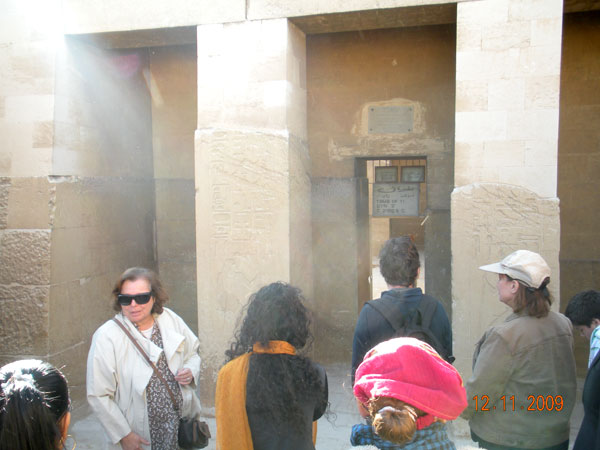

The most striking feature of the space, however, was the carvings of hieroglyphics and scenes of life that covered all four walls from a height of about five feet all the way to the ceiling. The carvings were arranged in horizontal bands, each about eighteen inches high. In many places the original paint was still visible. The carvings showed people from all walks of life engaging in everyday activities. Contrary to the impression many of us have of these scenes, that they are formal and rigid in their depiction of life, the scenes here were full of movement and activity. There were people catching fish from a boat, carpenters sawing wood and building boats, farmers carrying poultry to market, a cow being milked, young boys running. Interspersed among these scenes, periodically, were larger carvings of the deceased with his symbol of power, a long staff. In one such scene, Ti’s wife kneels behind him, one hand affectionately grasping his calf. His son, kneeling in front of him, grasps the lower part of the staff Ti is holding, a clue to their relationship and to the son’s role in life. In the wall opposite the entrance are three triangular piercings. Looking through these one sees a space where statues of the deceased once stood. A copy of one is all that now remains.
A short distance back down the corridor is a second smaller room where the annual offerings of food and drink would have been stored. The walls of this room, too, bear elaborate carvings. Like those of the first room, Dr, Karim tells us, the carvings here were done using stone tools. The Egyptians of this time did not yet have the metallurgical skills to make metal stone carving tools. Amazing.
Now was the time for the adventurous part of our outing. We returned to courtyard and in small groups descended the stairs to the underground burial chamber. Now, I’m not fond of tight spaces, particularly when there are a few hundred tons of rock over my head, but I knew I had to see the inside of at least one of these structures. At the bottom of the stairs was a narrow square opening leading to a tunnel perhaps ten yards long. Crouching and crabbing my way along, I scrambled along the passage, which had dim lighting at intervals, until I came to a space about ten feet square where I could stand up. The room was hewn out of solid rock and there wasn’t much headroom. There was another crawl space on the other side of this room and we had to resume our ungainly postures as we waddled through that. The second passage was a little shorter and we emerged into a second room with a ceiling about ten feet high.  On a wide rock shelf stood an empty sarcophagus, the lid pushed back so that one could peer in. The corpse of the deceased had long since disappeared, but there was no way to get that great stone box out except in pieces. After a short look around, the group re-emerged under its own power, unlike the original inhabitant.
On a wide rock shelf stood an empty sarcophagus, the lid pushed back so that one could peer in. The corpse of the deceased had long since disappeared, but there was no way to get that great stone box out except in pieces. After a short look around, the group re-emerged under its own power, unlike the original inhabitant.
We hopped back on the bus and took a short ride to another tomb in the same park. To the West of Ti’s tomb lies an assemblage of structures known as the Complex of Pepi II (6th Dynasty—around 2200 BC). This complex contains not only Pepi’s pyramid, but those of three of his wives and the remains of some temples as well. Pepi’s pyramid is built of limestone, so much of it still stands; the smooth outer covering, though, was long ago pilfered for building materials. There was access to this pyramid as well; an opening at ground level led to a ramp some one hundred feet long that led down through the rock at a steep angle. The floor had been covered with wooden planks onto which lengths of hollow square metal bars had been bolted. These served as steps as one descended.
This passage wasn’t any bigger than the first one; in fact, Dr. Karim had told us that we would REALLY have to bend to get through it. I followed a small group of my colleagues underground. Along the ramp were several stone channels set into the passage walls. Once upon a time, these held granite slabs that blocked the ramp and supposedly kept thieves out. Obviously not as effective as the designers intended…
At the bottom of the ramp, we had to squeeze under a huge block of red granite which served as a lintel over the passageway. Its purpose was to bear the weight of the stones laid on top of it. All the stones. We were told that the granite came from Aswan, a couple thousand kilometers up the Nile. None of us was terrible reassured by the numerous cracks it showed, some of them looking as though they had been patched with chewing gum.
There were two rooms at the bottom; the one on the right was an antechamber. The walls bore hieroglyphics, carvings of the Pharaoh, and his cartouche. The ceiling, which was gabled (i.e. it had a peak), was covered with stars carved to look like sea stars, a reference to the mythical ocean out of which Earth was created as well as a representation of the night sky. The size of the blocks, like Volkswagen buses, was astounding and the fact that some of them hung lower in the room than others didn’t make me want to hang around too long.
Once everyone was back above ground, we ran the customary gauntlet of souvenir and post card vendors and re-boarded the bus. A short ride brought us to the Pyramid of Zozer (3rd Dynasty, about 2650 BC). The first real pyramid built in Egypt, it lies over an earlier mastaba. This pyramid is about 100 feet high and is currently having extensive preservation work carried out on it. No one is allowed to enter this tomb because it is considered dangerous. Even in the time of the 11th Dynasty, some fifty years after Zozer, it was beginning to collapse and pillars were added inside to stabilize it.

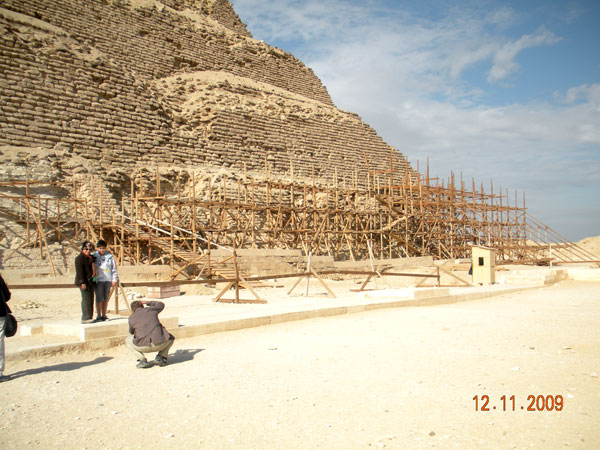
 As with the other pyramids, there was a temple complex connected to this one. An architectural advisor to the archaeologist who worked here in the 1920’s found stones from the enclosure wall under the sands and restored part of it, together with a colonnade of forty-two pillars carved to resemble bundles of reeds. There is also a ceremonial ground with the remains of two raised platforms. It was here that the Pharaoh, after a reign of thirty years, had to perform a ritual called the “Heb Sed,” during which he had to run seven times around a circuit about an eighth of a mile in length in order to prove his fitness to continue governing. I wondered how old Teti, who is reputed to have lived to the age of 94, managed that. Maybe there was no time limit…
As with the other pyramids, there was a temple complex connected to this one. An architectural advisor to the archaeologist who worked here in the 1920’s found stones from the enclosure wall under the sands and restored part of it, together with a colonnade of forty-two pillars carved to resemble bundles of reeds. There is also a ceremonial ground with the remains of two raised platforms. It was here that the Pharaoh, after a reign of thirty years, had to perform a ritual called the “Heb Sed,” during which he had to run seven times around a circuit about an eighth of a mile in length in order to prove his fitness to continue governing. I wondered how old Teti, who is reputed to have lived to the age of 94, managed that. Maybe there was no time limit…
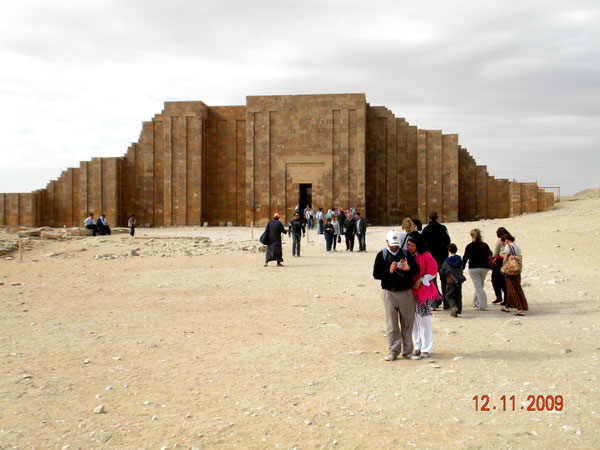
Leaving Saqqara, it was clear why the sandy verges of the desert were chosen for the pyramids. First, of course, there was a solid rock foundation to bear the enormous weight of these gigantic structures, but also, the fertile lands along the river were too valuable to be given up forever to dead folks. [DSCN0129] [DSCN0131] We now descended from the desert plateau to the irrigated lands along the Nile and headed to the remains of the ancient city of Memphis, the capital of the First Dynasty (ca. 3100 BC). Like most of the cities of those times, Memphis was built of mud brick, so very little remains except for the few buildings built of stone, statues and other stone monuments. Memphis stood here for three thousand years, until the time of Alexander the Great. The village of Mit Rihanah now occupies part of the site, and there is an outdoor museum that holds many of the important monumental artifacts found here.


There are a number of large stone jars, statues, stele with bearing inscriptions, and even a sphinx here, but the most spectacular object is an unfinished statue of Ramses II (19th Dynasty, 1304-1237 BC) which is more than forty feet long. Ramses II seems to have had an ego even bigger than his statues; his is one of the most common figures known. This example remained incomplete and is broken at mid-calf level. What is important about it is that it is in a very good state of preservation. It was never erected and lay covered by sand in its present location for thousands of years until it was discovered in 1820.
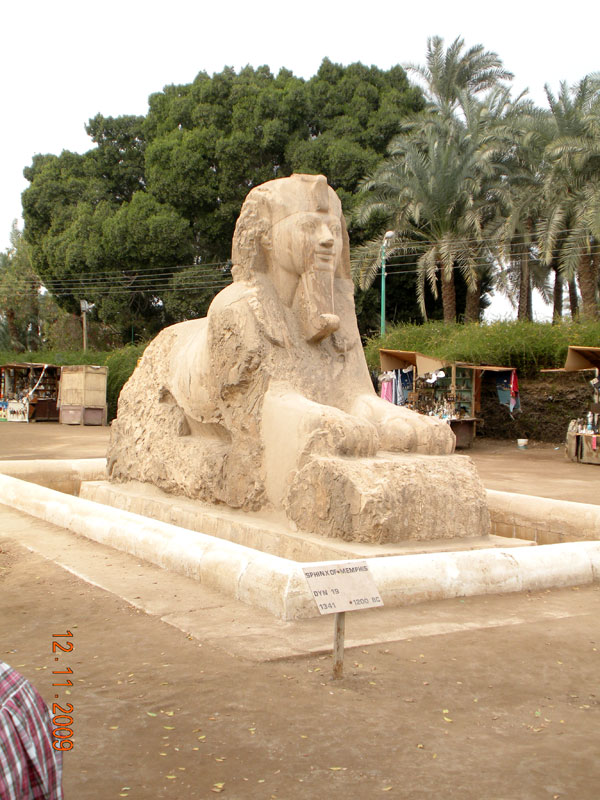

The skies had turned cloudy and the wind had picked up, so we were herded back to the bus once again and driven to the final stop on our pyramid tour, Dahshour. Here one sees the ultimate in conspicuous consumption as far as pyramids are concerned. Old Sneferu of the 4th Dynasty (ca. 2600-2500 BC), the immediate predecessor of Cheops (who had the pyramid at Giza constructed) built two of his three pyramids. Now, why anyone would need three pyramids, much less one, is quite beyond me, but here they were. The first, which we could view only from a distance since the road to it was unsuitable for our bus, is the so-called Bent Pyramid. From a distance, it looks like a mansard roof, with a change in the angle of its sides at about the mid-point of its elevation.

The reason for this is that an earlier pyramid built on the same model some ninety miles away collapsed while under construction. The engineers on the project concluded (wrongly, it turned out) that the reason for its collapse was the steep angle (53º) of the sides, so they altered the angle some ten degrees. Apparently unhappy with the funkiness of its design, Sneferu ordered the building of another pyramid, the one next to which we now found ourselves. [DSCN0138] It is known as the Red Pyramid because of the minerals in its stonework. It is over three hundred feet high and must have been even more impressive in its prime. Most of the finished limestone of the exterior disappeared long ago, as it did from many of the other pyramids.

The wind was carrying sprinkles of rain as we toured the grounds around the pyramid and those who had thought to bring along sweaters or jackets were commended by the rest of us for their foresight. We went to the east side where the temple complex had once stood and had a chance to perceive the monumental scale of the structure. On a plinth at the base of the pyramid stood its capstone, or “pyramidion,” which had been found, undamaged, at the base by the archaeologists who excavated here.
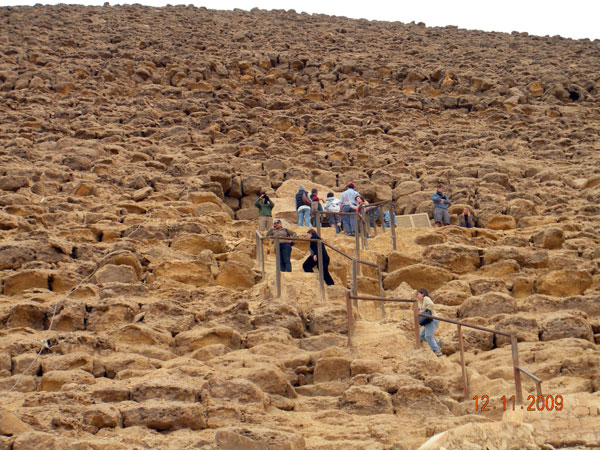 The interior of this pyramid was accessible to the adventurous so those wanting to see the inside climbed a crude staircase to a point about halfway up the north face and entered yet another tight fitting sloping passageway. One crabs along for about 150 feet to the first of two chambers at the base of the pyramid—if one wants to. I got about halfway down and was overwhelmed by the humidity and rather unpleasant odors wafting up from below, so I retreated. Seen one claustrophobia-inducing space, seen them all. Those intrepid souls who made it down and back emerged gasping for air and complaining of the noxious odors that greeted them in the basement. In true Egyptian fashion, there was a ventilating unit parked at an angle next to the entry, but it wasn’t connected to any electrical source and obviously hadn’t worked in some time. From our perch next to the entryway on the pyramid, we could see at least ten other pyramids dotting the landscape, all the way to Giza.
The interior of this pyramid was accessible to the adventurous so those wanting to see the inside climbed a crude staircase to a point about halfway up the north face and entered yet another tight fitting sloping passageway. One crabs along for about 150 feet to the first of two chambers at the base of the pyramid—if one wants to. I got about halfway down and was overwhelmed by the humidity and rather unpleasant odors wafting up from below, so I retreated. Seen one claustrophobia-inducing space, seen them all. Those intrepid souls who made it down and back emerged gasping for air and complaining of the noxious odors that greeted them in the basement. In true Egyptian fashion, there was a ventilating unit parked at an angle next to the entry, but it wasn’t connected to any electrical source and obviously hadn’t worked in some time. From our perch next to the entryway on the pyramid, we could see at least ten other pyramids dotting the landscape, all the way to Giza.
Having tempted the mummy’s curse three times in one day, we traveled back to Giza where we were rewarded for our intrepidness with another Fulbright custom: a meal at a great restaurant. Our stop today was Andrea’s, a place popular with both Egyptians and tourists. We climbed down from the bus on a street running alongside a recently dredged canal and walked into a very pleasant walled courtyard. Descending a short flight of stairs, we entered a courtyard paved with stone. Servers in white shirts, black trousers, and vests bustled about carrying trays or escorting guests to their seats. To the left of the entryway was a huge barbecue with a few dozen chickens and other poultry roasting above a bed of coals. Smoke billowed thickly, obscuring the white-coated chef who supervised the cooking. Just next to the rotisserie was a brick bread oven attended by half a dozen women baking pita. We were offered samples—for a token fee—as we approached and some people stopped to taste.

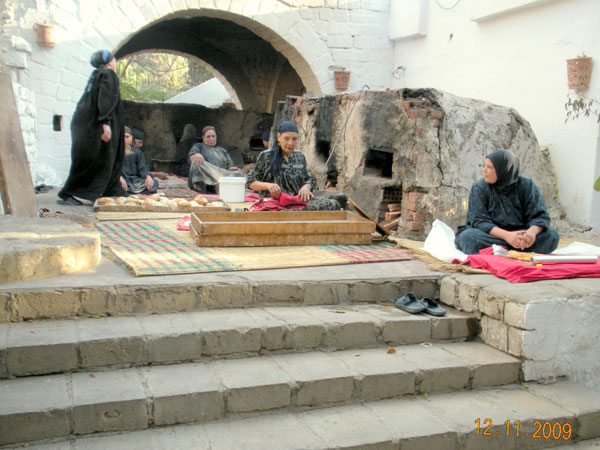
The restaurant had been awaiting our arrival and we were shown to our tables, two long rustic wooden affairs surrounded by equally rustic low chairs. The fare here was basic: three varieties of poultry (chicken, quail, or pigeon), rice, fresh bread, and the usual assortment of appetizers. We placed our orders and talked over plates of Baba Ghanoush, hoummus, pickled beets, stuffed vine leaves, and tahini salad. In short order, our meals arrived and we dug in. It was all good. For a while, it looked as though we might have to retreat to shelter since the wind and clouds built ominously, but the sky soon cleared and we finished out meals without getting wet.
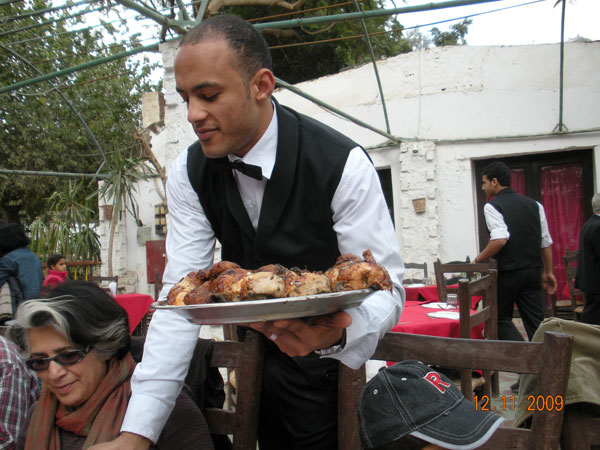
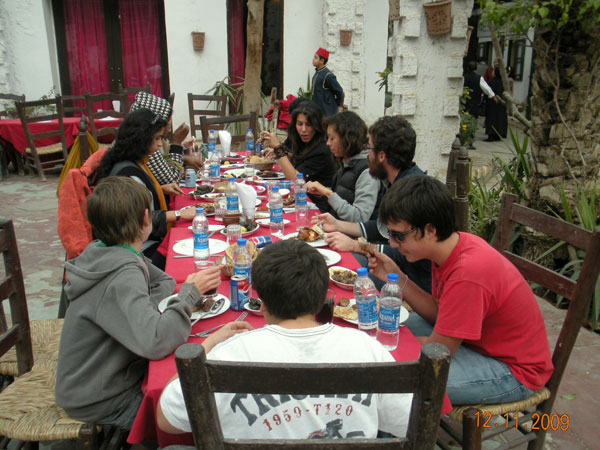
Stomachs and heads full, we piled once more onto the bus and headed back to the Fulbright office. A day well spent and deserving of a relaxing evening during which we might reflect on it.
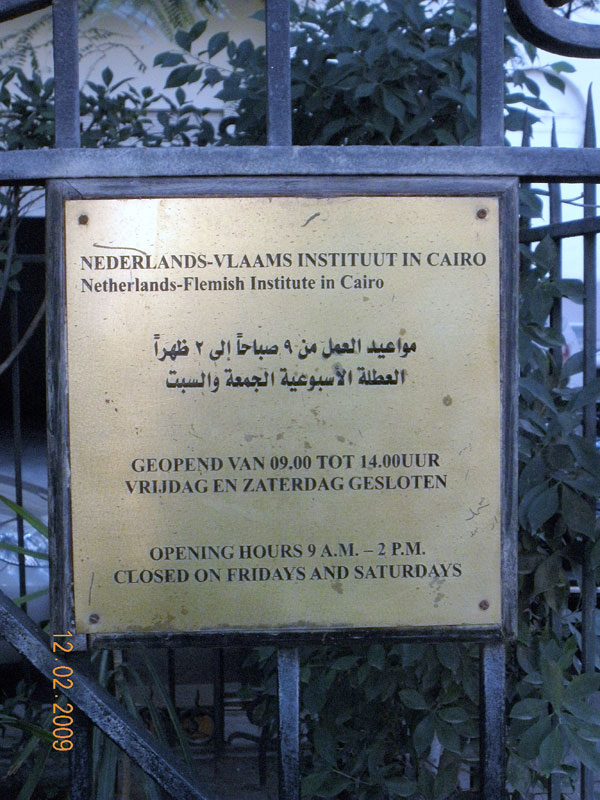 Oh, THERE it is, complete with brass plaque identifying it. Right around the corner from Ginger’s apartment, to her surprise. We thank the guard and I head back to the apartment to put my feet up. I spend rest of the afternoon catching up on blog entries and editing the collection development policy statements which are beginning to trickle in from the selectors at the Bibliotheca. By 6:30, Belle hasn’t shown up so I decide to walk across the river and try the restaurant that Ginger and I had seen earlier in the day. I eat a middling meal of eggplant moussaka amid couples chatting over their own meals and smoking to excess.
Oh, THERE it is, complete with brass plaque identifying it. Right around the corner from Ginger’s apartment, to her surprise. We thank the guard and I head back to the apartment to put my feet up. I spend rest of the afternoon catching up on blog entries and editing the collection development policy statements which are beginning to trickle in from the selectors at the Bibliotheca. By 6:30, Belle hasn’t shown up so I decide to walk across the river and try the restaurant that Ginger and I had seen earlier in the day. I eat a middling meal of eggplant moussaka amid couples chatting over their own meals and smoking to excess.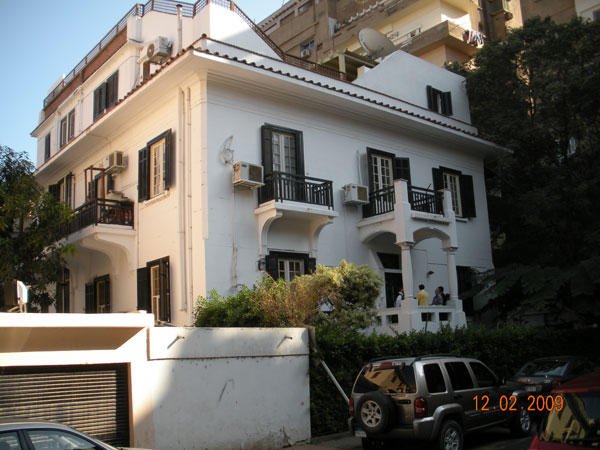 Wednesday morning comes too soon. I haven’t slept well and have to drag myself up. Belle is already in the kitchen finishing her breakfast as I come in to make some tea. I had offered to treat her to dinner in gratitude for her hospitality, and we decide to meet this evening. She heads off and I start getting ready for the first day of the workshop. I had made use of the washing machine the day before and now had clothing free of desert dust, but I still needed to iron a shirt. I took care of that and then dressed and grabbed a cab for Zamalek.
Wednesday morning comes too soon. I haven’t slept well and have to drag myself up. Belle is already in the kitchen finishing her breakfast as I come in to make some tea. I had offered to treat her to dinner in gratitude for her hospitality, and we decide to meet this evening. She heads off and I start getting ready for the first day of the workshop. I had made use of the washing machine the day before and now had clothing free of desert dust, but I still needed to iron a shirt. I took care of that and then dressed and grabbed a cab for Zamalek. There were a few high clouds in the sky but they weren’t thick enough to block the sunlight. The camp was still relatively quiet at this early hour. The music the previous evening had gone on until almost midnight and many people were sleeping in, if they could. The chef was up and slowly getting breakfast on the table. Someone was stirring a campfire to life. The campsite was beginning to look a little shopworn; bits of litter peeked from the sand here and there; the port-a-potty was filling up; the chef’s white jacket was smudged with grease and soot. Nonetheless, there was soon hot water for tea and Nescafe and the day looked a bit brighter after a cup or two.
There were a few high clouds in the sky but they weren’t thick enough to block the sunlight. The camp was still relatively quiet at this early hour. The music the previous evening had gone on until almost midnight and many people were sleeping in, if they could. The chef was up and slowly getting breakfast on the table. Someone was stirring a campfire to life. The campsite was beginning to look a little shopworn; bits of litter peeked from the sand here and there; the port-a-potty was filling up; the chef’s white jacket was smudged with grease and soot. Nonetheless, there was soon hot water for tea and Nescafe and the day looked a bit brighter after a cup or two.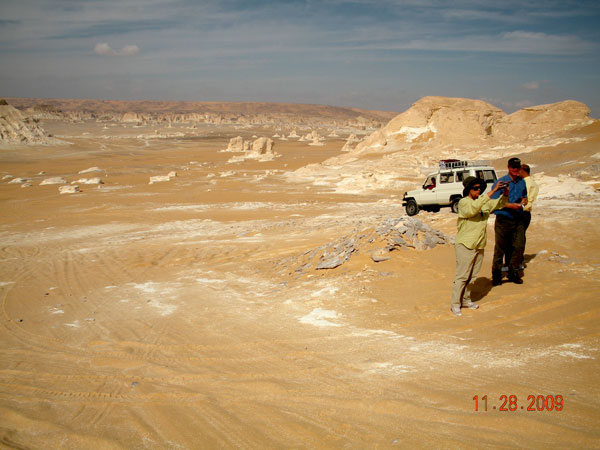

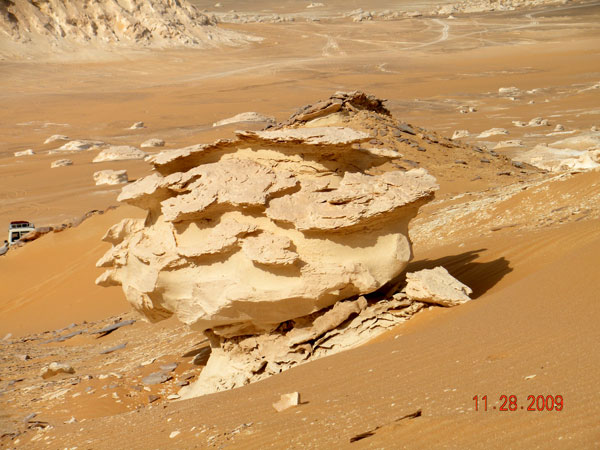
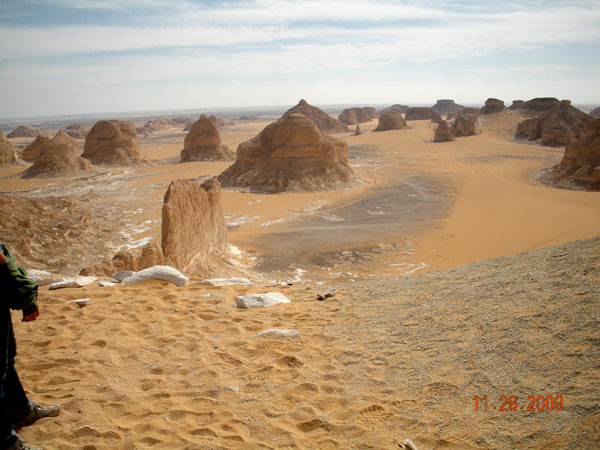


 At each stop we competed with each other in discovering the most unusual example. Ginger returned to Cairo with a pack weighing twice what it did when she set out. There were places where the black rocks stuck up out of the white stone like mails in a piece of wood; frequently, on exposed rock faces, the black stones were visible, embedded in the chalk. This material must have rained down on the ancient sea and, cooling as it sank, stuck into the still soft sediment at the sea bottom where it was eventually covered by eons of crustaceous carcasses. Elsewhere, we found the remnants of ancient seashells embedded in the chalk as well. Some of the black stones even bore the impressions of seashells. Glad I wasn’t around for that “weather event.”
At each stop we competed with each other in discovering the most unusual example. Ginger returned to Cairo with a pack weighing twice what it did when she set out. There were places where the black rocks stuck up out of the white stone like mails in a piece of wood; frequently, on exposed rock faces, the black stones were visible, embedded in the chalk. This material must have rained down on the ancient sea and, cooling as it sank, stuck into the still soft sediment at the sea bottom where it was eventually covered by eons of crustaceous carcasses. Elsewhere, we found the remnants of ancient seashells embedded in the chalk as well. Some of the black stones even bore the impressions of seashells. Glad I wasn’t around for that “weather event.” We continued driving through the depression, entering a flat area with row upon row of white stone pillars which we had to slalom our way through. At times I doubted Ashari’s sense of distances as we squeezed through gaps that I feared would leave us jammed between two walls of rock, but he piloted us through without so much as a scratch on the doors. t a relatively open space, he stopped and let us out to take some photos and explore a bit. Within minutes, Jamie had disappeared and I saw how easily one could become disoriented and lost in this place. The rock formations were ever-changing; there were several in this spot that looked like nothing so much as a piece of mille feuille pastry drizzled with a sugary icing. More wondering about what sort of geological process had created such masterpieces. Every turn revealed something new and surprising.
We continued driving through the depression, entering a flat area with row upon row of white stone pillars which we had to slalom our way through. At times I doubted Ashari’s sense of distances as we squeezed through gaps that I feared would leave us jammed between two walls of rock, but he piloted us through without so much as a scratch on the doors. t a relatively open space, he stopped and let us out to take some photos and explore a bit. Within minutes, Jamie had disappeared and I saw how easily one could become disoriented and lost in this place. The rock formations were ever-changing; there were several in this spot that looked like nothing so much as a piece of mille feuille pastry drizzled with a sugary icing. More wondering about what sort of geological process had created such masterpieces. Every turn revealed something new and surprising.
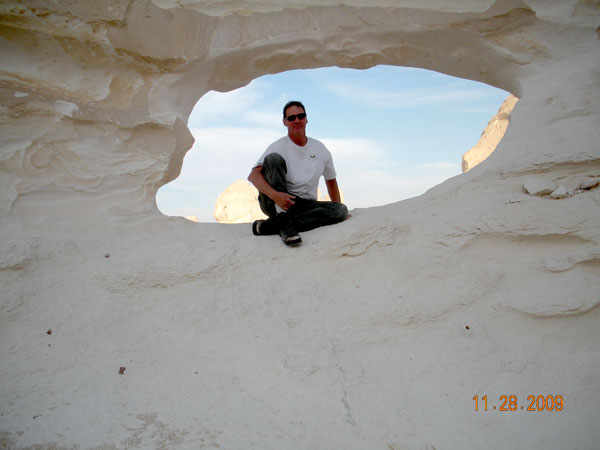
 Our penultimate stop was in a canyon surrounded by towering white cliffs. To one side was a jagged pillar of white rock easily 200 feet high; at its base was a hole that allowed us to crawl through from one side to the other. I tried to keep from my consciousness the fact that several hundreds of thousands of tons of rock sat above us. The final leg of our journey brought us up out of the basin and across the paved road to another area where white rock pillars dominated the landscape. There was again a myriad of shapes and forms stretching away, but in truth this dimmed in comparison to what we had seen earlier in the day. Still, it was an impressive way to end our tour.
Our penultimate stop was in a canyon surrounded by towering white cliffs. To one side was a jagged pillar of white rock easily 200 feet high; at its base was a hole that allowed us to crawl through from one side to the other. I tried to keep from my consciousness the fact that several hundreds of thousands of tons of rock sat above us. The final leg of our journey brought us up out of the basin and across the paved road to another area where white rock pillars dominated the landscape. There was again a myriad of shapes and forms stretching away, but in truth this dimmed in comparison to what we had seen earlier in the day. Still, it was an impressive way to end our tour.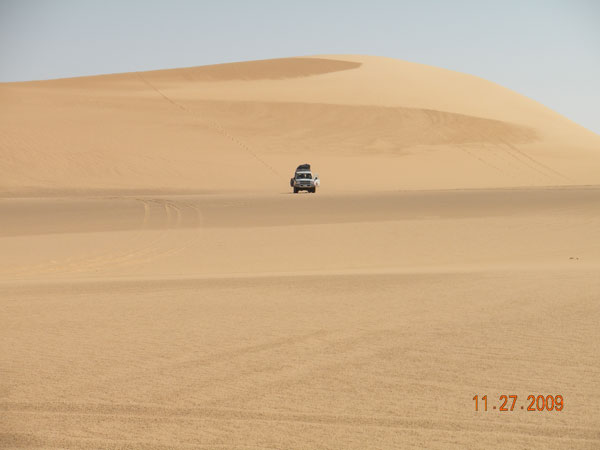
 From the backs of two of the expedition vehicles snowboards were produced and everyone headed up the slope of the dune for some sand skiing. The kids, of course were the most enthusiastic and adventurous. The bottoms of the boards were coated with formica, which was meant to make them slippery on the sand. They worked reasonably well, but except for the most precipitous slope near the end of the dune, no breathtaking speeds were achieved. We spent a good hour during which everyone had at least one ride down the dune. I felt like a real Americano tourist, but really, how many chances does one get to do that? Of course there was one testosterone powered idiot who had to prove his car was the most powerful machine ever built and he drove to the crest of the dune, receiving the cheers of his fellow SUV owners. The cheers quickly died however, when the car sank into the sand. He and his friends spent forty-five minutes digging and shifting a pair of sand sheets under various wheels until he finally managed to get free. Sometimes guys are SO predictable.
From the backs of two of the expedition vehicles snowboards were produced and everyone headed up the slope of the dune for some sand skiing. The kids, of course were the most enthusiastic and adventurous. The bottoms of the boards were coated with formica, which was meant to make them slippery on the sand. They worked reasonably well, but except for the most precipitous slope near the end of the dune, no breathtaking speeds were achieved. We spent a good hour during which everyone had at least one ride down the dune. I felt like a real Americano tourist, but really, how many chances does one get to do that? Of course there was one testosterone powered idiot who had to prove his car was the most powerful machine ever built and he drove to the crest of the dune, receiving the cheers of his fellow SUV owners. The cheers quickly died however, when the car sank into the sand. He and his friends spent forty-five minutes digging and shifting a pair of sand sheets under various wheels until he finally managed to get free. Sometimes guys are SO predictable.

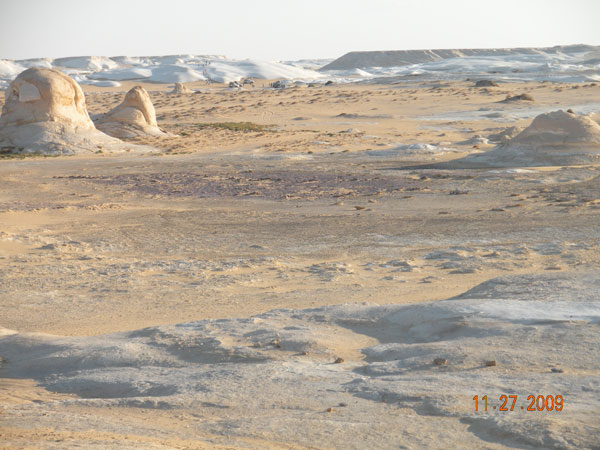



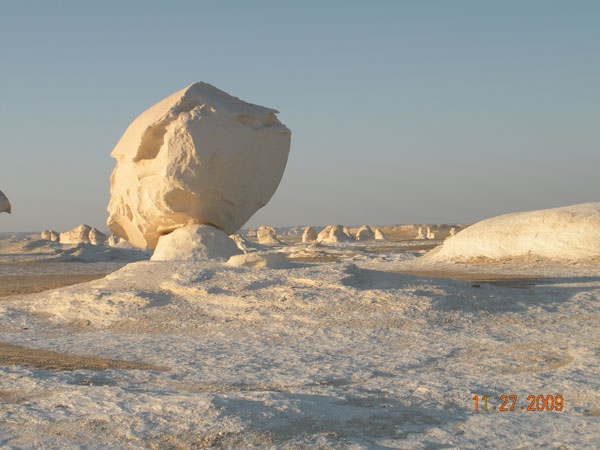 The sun was settling toward the horizon as we reached our last stop of the day. One of the most famous areas of the White Desert contains chalk formations shaped by the winds into marvelous figures. This particular location was known as the Mushrooms and there were indeed several that looked for all the world like fungi, but the variety of shapes was endless. One was also struck by the fragility of these monuments, for everywhere one could see where huge chunks of rock had recently fallen away, splitting along fracture lines and shattering into smaller pieces as they struck the ground. I realized that what we were seeing was a snapshot of what was and what would be. Visitors to this same place in two years time—perhaps less—would see something quite different.
The sun was settling toward the horizon as we reached our last stop of the day. One of the most famous areas of the White Desert contains chalk formations shaped by the winds into marvelous figures. This particular location was known as the Mushrooms and there were indeed several that looked for all the world like fungi, but the variety of shapes was endless. One was also struck by the fragility of these monuments, for everywhere one could see where huge chunks of rock had recently fallen away, splitting along fracture lines and shattering into smaller pieces as they struck the ground. I realized that what we were seeing was a snapshot of what was and what would be. Visitors to this same place in two years time—perhaps less—would see something quite different.
 After about two hours, the road dropped into a major depression in the earth; we descended several hundred feet over several miles on a graded roadbed. The escarpment of the depression was visible as a series of cliffs off to the north. These depressions were where we would find the oases that provided small groups of people with a tenuous grip on life here amidst all this aridity. There is a string of such depressions across the desert here that hold what are called the “Inner Oases,” Bahriya, Farafra, Dakhla, and Siwa a bit to the north. Our first stop was Bahriya, where we had to pass through a checkpoint manned by the police. We stopped and our driver was asked how many foreigners he had with him and what our nationalities were. One of the Egyptian women translated and we relayed the requested information to the cops. Our driver, Abd Allah, was obviously known to them because there was a lengthy conversation, an exchange of news, before we resumed our travel.
After about two hours, the road dropped into a major depression in the earth; we descended several hundred feet over several miles on a graded roadbed. The escarpment of the depression was visible as a series of cliffs off to the north. These depressions were where we would find the oases that provided small groups of people with a tenuous grip on life here amidst all this aridity. There is a string of such depressions across the desert here that hold what are called the “Inner Oases,” Bahriya, Farafra, Dakhla, and Siwa a bit to the north. Our first stop was Bahriya, where we had to pass through a checkpoint manned by the police. We stopped and our driver was asked how many foreigners he had with him and what our nationalities were. One of the Egyptian women translated and we relayed the requested information to the cops. Our driver, Abd Allah, was obviously known to them because there was a lengthy conversation, an exchange of news, before we resumed our travel. The Bahriya Oasis is the “gateway” to the desert, as it were, and the road here was lined with trees that looked like poplars. Behind them were fields and groves of what looked like tropical fruit trees. Mud brick and stone houses began to appear. Within five miles, we were in the oasis proper and we had to make another stop. Here, in front of the main police station, our passports were collected and we were then transported about five hundred yards down the road and dumped off at a restaurant where several locals sat drinking tea and smoking shishas in the shade of an aluminum awning. Thankfully, the comfort facilities here were respectable and the restaurant itself clean and quiet. We ordered tea and sat at a table.
The Bahriya Oasis is the “gateway” to the desert, as it were, and the road here was lined with trees that looked like poplars. Behind them were fields and groves of what looked like tropical fruit trees. Mud brick and stone houses began to appear. Within five miles, we were in the oasis proper and we had to make another stop. Here, in front of the main police station, our passports were collected and we were then transported about five hundred yards down the road and dumped off at a restaurant where several locals sat drinking tea and smoking shishas in the shade of an aluminum awning. Thankfully, the comfort facilities here were respectable and the restaurant itself clean and quiet. We ordered tea and sat at a table.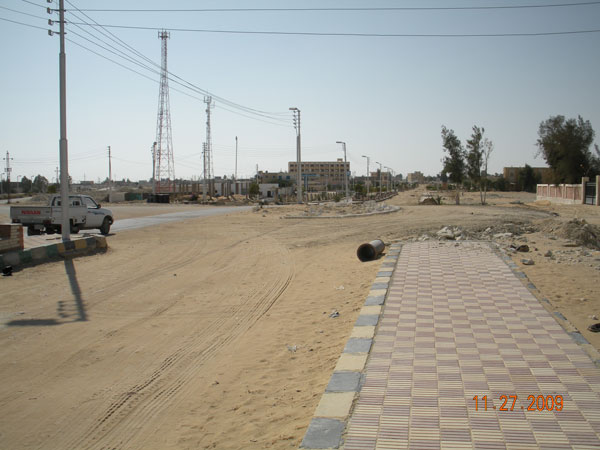
 Hardly more than a thirty-foot mound with a small person-sized rock arch to one side, the formation is composed of quartz crystals and probably would be quite a sight in the sun after a good rain shower to wash the dust off. We wandered around the site for a few minutes, looked for crystals in the dirt of the parking area and then climbed back into the car.
Hardly more than a thirty-foot mound with a small person-sized rock arch to one side, the formation is composed of quartz crystals and probably would be quite a sight in the sun after a good rain shower to wash the dust off. We wandered around the site for a few minutes, looked for crystals in the dirt of the parking area and then climbed back into the car. The Toyota pulled up adjacent to the tents and we unfolded ourselves from the back. A long arcade of shelters made of dark woolen or camel hair rugs stretched along the sand on one side of the site. There was a cook tent, a couple of old wooden tables standing front it and a second arcade of open shelters beyond it. At either end of the row of tents was a tall pillar of white rock, scoured by wind and blown sand into fantastic shapes. To the west, a low white ridge of the same rock glowed in the sun. Smaller bleached formations stood all around on the horizon. In between the white rocks were expanses of sand, some deep and soft, others rippled by the wind and packed hard.
The Toyota pulled up adjacent to the tents and we unfolded ourselves from the back. A long arcade of shelters made of dark woolen or camel hair rugs stretched along the sand on one side of the site. There was a cook tent, a couple of old wooden tables standing front it and a second arcade of open shelters beyond it. At either end of the row of tents was a tall pillar of white rock, scoured by wind and blown sand into fantastic shapes. To the west, a low white ridge of the same rock glowed in the sun. Smaller bleached formations stood all around on the horizon. In between the white rocks were expanses of sand, some deep and soft, others rippled by the wind and packed hard.

 We set off through Cairo traffic, which was beginning to build at that hour. It took us a good hour to clear Cairo and then we were on the four-lane headed south toward the Fayyoum. I had ridden this same road earlier in the month when I visited Karanis so I busied myself with breakfast and chatting with my travel mates: Virginia da Costa, Dominique Ellis, Breonna Arder, and Joe Yackley, our newest member who is pursuing dissertation research in Egypt and Turkey later on. The Toyota we were in was not the newest ride on the road and had obviously seen some rough cross country travel. The suspension was stiff and that, combined with a short wheel base, made for a rough journey, even on the paved road. To add to our discomfort, Dominique and Breonna, who had chosen to ride in the rear seats, had to deal with gasoline fumes. For this reason as well as to give people different conversation partners, we switched seats occasionally.
We set off through Cairo traffic, which was beginning to build at that hour. It took us a good hour to clear Cairo and then we were on the four-lane headed south toward the Fayyoum. I had ridden this same road earlier in the month when I visited Karanis so I busied myself with breakfast and chatting with my travel mates: Virginia da Costa, Dominique Ellis, Breonna Arder, and Joe Yackley, our newest member who is pursuing dissertation research in Egypt and Turkey later on. The Toyota we were in was not the newest ride on the road and had obviously seen some rough cross country travel. The suspension was stiff and that, combined with a short wheel base, made for a rough journey, even on the paved road. To add to our discomfort, Dominique and Breonna, who had chosen to ride in the rear seats, had to deal with gasoline fumes. For this reason as well as to give people different conversation partners, we switched seats occasionally. Before long, we were nearing the turnoff for the Fayyoum oasis. I saw the Karanis excavation off to the left of the road and knew we were getting near.
Before long, we were nearing the turnoff for the Fayyoum oasis. I saw the Karanis excavation off to the left of the road and knew we were getting near. 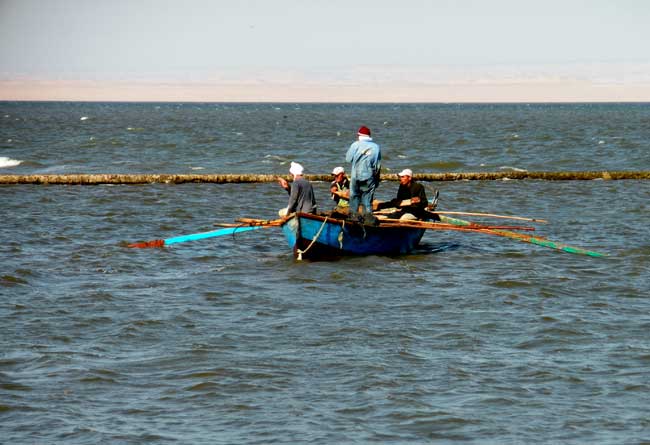
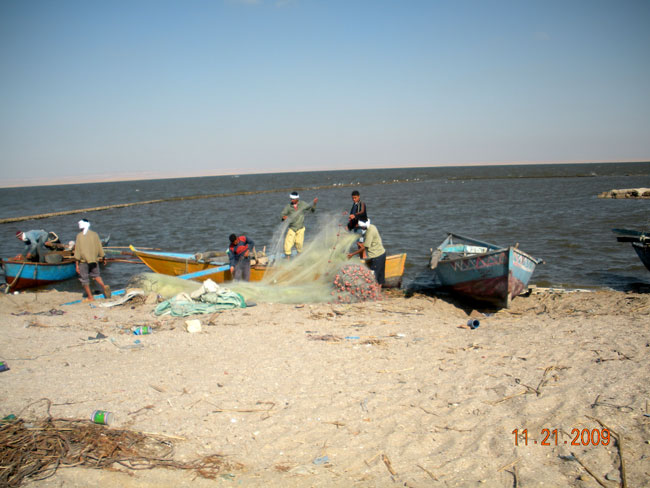
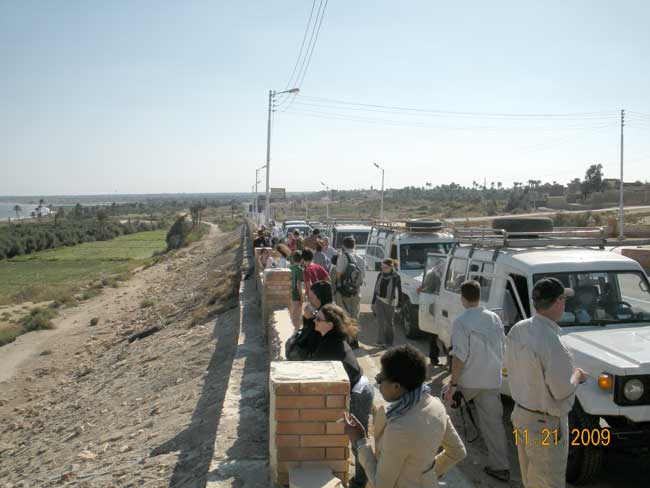 We made a brief stop so that people could take photos and then continued our journey. Our destination was an archeological excavation in a geographical feature called Wadi al-Hitan or the Valley of the Whales. Yes, in the desert, there is a place where one can see what’s left of whales. Of course they are forty-million-year-old whales but they are (or were) whales. One species in particular, the Basilosaurus, is found only here and its importance to paleontologists and those who study evolution lies in the fact that they had vestigial feet. In other words, whales were once land dwellers who decided that the ocean offered a better living and returned to the primordial soup as it were.
We made a brief stop so that people could take photos and then continued our journey. Our destination was an archeological excavation in a geographical feature called Wadi al-Hitan or the Valley of the Whales. Yes, in the desert, there is a place where one can see what’s left of whales. Of course they are forty-million-year-old whales but they are (or were) whales. One species in particular, the Basilosaurus, is found only here and its importance to paleontologists and those who study evolution lies in the fact that they had vestigial feet. In other words, whales were once land dwellers who decided that the ocean offered a better living and returned to the primordial soup as it were. We arrived at the visitors’ center and alighted from the trucks. We walked about for a few minutes to work the kinks out and take in the landscape. The area reminded me of the desert southwest in the States, but without the variety of colors. Still, the rock formations were impressive, having been sculpted by the sand and the wind over untold millennia. We gathered at one of the buildings and received a brief orientation from the head paleontologist who explained the geology of the region and the importance of the site. He explained that there were there distinct geological layers found here representing a cross-section of several tens of millions of years. Whales continued to live here during all of that time until the Earth’s climate began to cool and the polar ice caps formed, pulling liquid water away from the planet’s girth. Now it looks as though we’re reversing course once again. The paleontologist also showed us some fossilized remains of the whales and explained how they came to be preserved. The remains were covered quickly by silt or sand and the soft tissues decayed quickly. That allowed the minerals in the water and earth to replace the organic material of the skeletons and fossilize them.
We arrived at the visitors’ center and alighted from the trucks. We walked about for a few minutes to work the kinks out and take in the landscape. The area reminded me of the desert southwest in the States, but without the variety of colors. Still, the rock formations were impressive, having been sculpted by the sand and the wind over untold millennia. We gathered at one of the buildings and received a brief orientation from the head paleontologist who explained the geology of the region and the importance of the site. He explained that there were there distinct geological layers found here representing a cross-section of several tens of millions of years. Whales continued to live here during all of that time until the Earth’s climate began to cool and the polar ice caps formed, pulling liquid water away from the planet’s girth. Now it looks as though we’re reversing course once again. The paleontologist also showed us some fossilized remains of the whales and explained how they came to be preserved. The remains were covered quickly by silt or sand and the soft tissues decayed quickly. That allowed the minerals in the water and earth to replace the organic material of the skeletons and fossilize them. The paleontologist soon led us off on a tour of the area. The path through the site was marked by stones and clay pots. At various locations, examples of the skeletons were on display. Some of the exhibits were clearly staged and the scientist acknowledged this. He said that one species in particular had a tendency to curl in death—probably due to contractions in the heavy muscles—and the scientists had straightened out the display skeletons so that people could get a clearer idea of the scale and composition of the bones. The exhibits are scattered over quite a wide area and an hour’s walk didn’t bring us anywhere near the end of the trail. In addition to animal fossils, there were interesting examples of fossilized plant remains as well. Near the mouth of an ancient river, in brackish water was a mangrove swamp; some of the tree roots had been fossilized and are now preserved in stone.
The paleontologist soon led us off on a tour of the area. The path through the site was marked by stones and clay pots. At various locations, examples of the skeletons were on display. Some of the exhibits were clearly staged and the scientist acknowledged this. He said that one species in particular had a tendency to curl in death—probably due to contractions in the heavy muscles—and the scientists had straightened out the display skeletons so that people could get a clearer idea of the scale and composition of the bones. The exhibits are scattered over quite a wide area and an hour’s walk didn’t bring us anywhere near the end of the trail. In addition to animal fossils, there were interesting examples of fossilized plant remains as well. Near the mouth of an ancient river, in brackish water was a mangrove swamp; some of the tree roots had been fossilized and are now preserved in stone.  A little distance away we saw the petrified trunk of a tree that had fallen into the ancient river and had been colonized by some sort of worm and the hole they left were then inhabited by a pencil-shaped bi-valve and their remains were fossilized also.
A little distance away we saw the petrified trunk of a tree that had fallen into the ancient river and had been colonized by some sort of worm and the hole they left were then inhabited by a pencil-shaped bi-valve and their remains were fossilized also. After fruit and tea, we saddled up again and left the area, driving back on the same dirt track. On the way back, we stopped at another geologically important area dominated by two round mountains rising against an artificial lake in the background. Here we stopped for a brief photo opportunity and a chance to pick up some fossils. The ground was covered by small disc-shaped stones ranging from dime to quarter size and varying in color from sand to light pink. These are the fossilized remains of a forty-million year-old single-cell animal from the order foraminifera. The locals call them “ancient coins.”
After fruit and tea, we saddled up again and left the area, driving back on the same dirt track. On the way back, we stopped at another geologically important area dominated by two round mountains rising against an artificial lake in the background. Here we stopped for a brief photo opportunity and a chance to pick up some fossils. The ground was covered by small disc-shaped stones ranging from dime to quarter size and varying in color from sand to light pink. These are the fossilized remains of a forty-million year-old single-cell animal from the order foraminifera. The locals call them “ancient coins.”